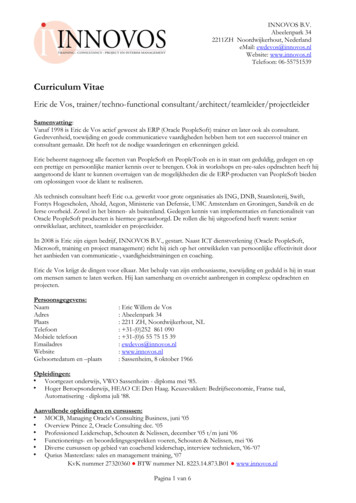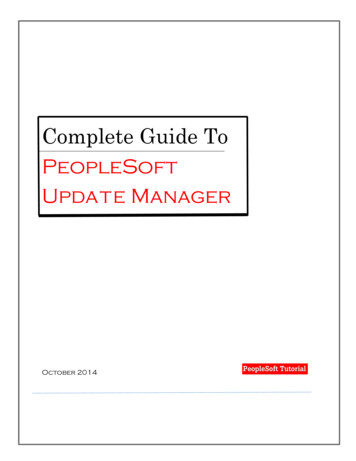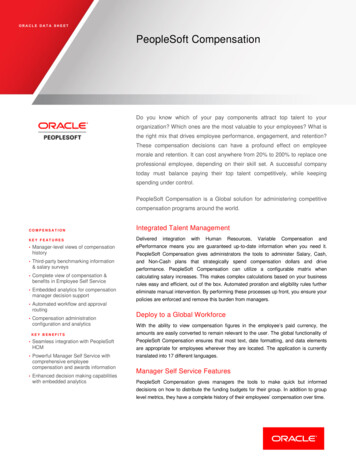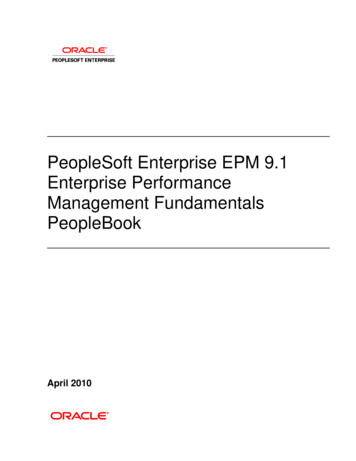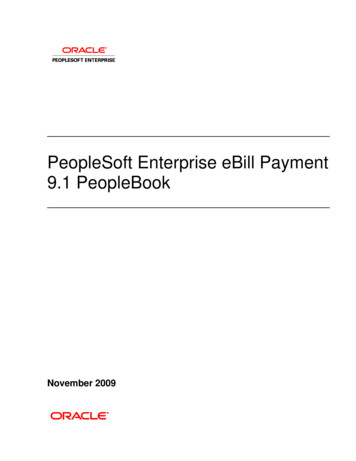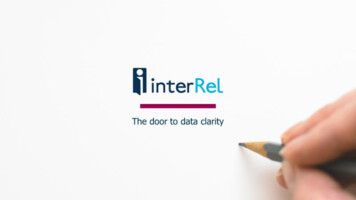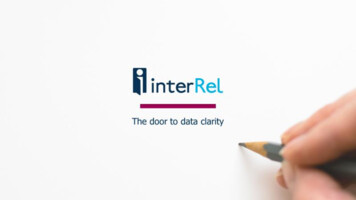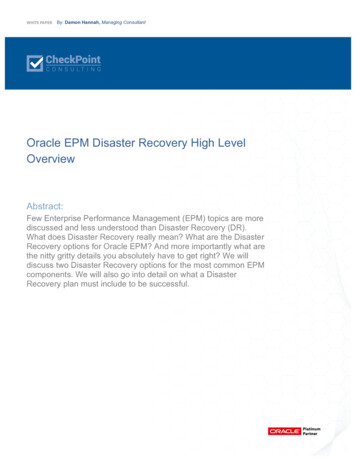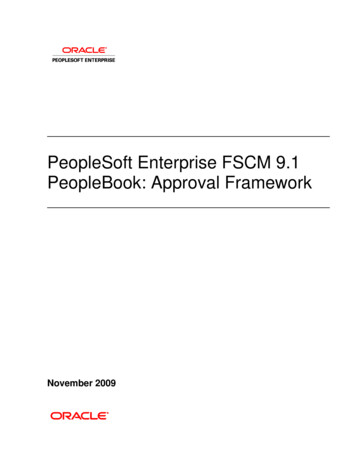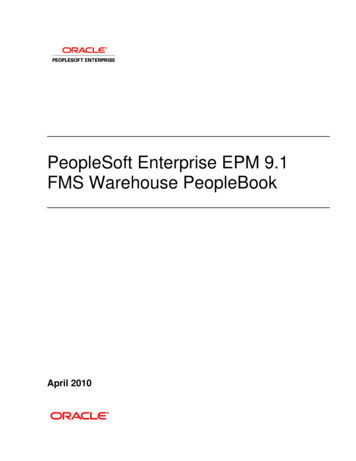
Transcription
PeopleSoft Enterprise EPM 9.1FMS Warehouse PeopleBookApril 2010
PeopleSoft Enterprise EPM 9.1 FMS Warehouse PeopleBookSKU epm91fwhs-b0410Copyright 1999, 2010, Oracle and/or its affiliates. All rights reserved.Trademark NoticeOracle is a registered trademark of Oracle Corporation and/or its affiliates. Other names may be trademarks of theirrespective owners.License Restrictions Warranty/Consequential Damages DisclaimerThis software and related documentation are provided under a license agreement containing restrictions on use anddisclosure and are protected by intellectual property laws. Except as expressly permitted in your license agreement orallowed by law, you may not use, copy, reproduce, translate, broadcast, modify, license, transmit, distribute, exhibit,perform, publish or display any part, in any form, or by any means. Reverse engineering, disassembly, or decompilationof this software, unless required by law for interoperability, is prohibited.Warranty DisclaimerThe information contained herein is subject to change without notice and is not warranted to be error-free. If you findany errors, please report them to us in writing.Restricted Rights NoticeIf this software or related documentation is delivered to the U.S. Government or anyone licensing it on behalf of the U.S.Government, the following notice is applicable:U.S. GOVERNMENT RIGHTSPrograms, software, databases, and related documentation and technical data delivered to U.S. Governmentcustomers are "commercial computer software" or "commercial technical data" pursuant to the applicableFederal Acquisition Regulation and agency-specific supplemental regulations. As such, the use, duplication,disclosure, modification, and adaptation shall be subject to the restrictions and license terms set forth in theapplicable Government contract, and, to the extent applicable by the terms of the Government contract, theadditional rights set forth in FAR 52.227-19, Commercial Computer Software License (December 2007).Oracle USA, Inc., 500 Oracle Parkway, Redwood City, CA 94065.Hazardous Applications NoticeThis software is developed for general use in a variety of information management applications. It is not developed orintended for use in any inherently dangerous applications, including applications which may create a risk of personalinjury. If you use this software in dangerous applications, then you shall be responsible to take all appropriate fail-safe,backup, redundancy and other measures to ensure the safe use of this software. Oracle Corporation and its affiliatesdisclaim any liability for any damages caused by use of this software in dangerous applications.Third Party Content, Products, and Services DisclaimerThis software and documentation may provide access to or information on content, products and services from thirdparties. Oracle Corporation and its affiliates are not responsible for and expressly disclaim all warranties of any kindwith respect to third party content, products and services. Oracle Corporation and its affiliates will not be responsible forany loss, costs, or damages incurred due to your access to or use of third party content, products or services.
ContentsPrefacePeopleSoft Enterprise Financial Management Solutions Warehouse Preface . ixOracle's PeopleSoft Products . ixPeopleSoft Application Fundamentals . ixPeopleBooks and the Online PeopleSoft Library . ixChapter 1Getting Started with PeopleSoft Enterprise Financial Management Solutions Warehouse . 1PeopleSoft Enterprise Financial Management Solutions Warehouse Overview . 1Other Sources of Information . 1Chapter 2Understanding the EPM Warehouses . 3Overview of PeopleSoft EPM Warehouses . 3Campus Solutions Warehouse . 3CRM Warehouse . 4FMS Warehouse . 5Financials Warehouse for Public Sector and Higher Education . 5HCM Warehouse . 6SCM Warehouse . 6Components of PeopleSoft EPM Warehouses . 7Extract Transform and Load (ETL) Component . 7Infrastructure Tables and Tools . 7Security Tables . 8Staging Tables . 8Multidimensional Warehouse Fact Tables . 8Multidimensional Warehouse Dimension Tables . 9Data Models . 12Measures . 12EPM Architecture and Data Flow . 13Operational Warehouse - Staging (OWS) . 14Operational Warehouse - Enriched (OWE) . 14Multidimensional Warehouse (MDW) . 15Copyright 1999, 2010, Oracle and/or its affiliates. All Rights Reserved.iii
ContentsReporting on the EPM Warehouses . 15Chapter 3Understanding the FMS Warehouse . 17FMS Warehouse Overview .Understanding the FMS Warehouse Structure .Enterprise Service Automation (ESA) Data Mart .Enterprise Service Automation Data Mart Delivered Fact and Dimension Tables .General Ledger and Profitability Data Mart .General Ledger and Profitability Data Mart Delivered Fact and Dimension Tables .Payables Data Mart .Payables Data Mart Delivered Fact and Dimension Tables .Receivables Data Mart .Receivables Data Mart Delivered Fact and Dimension Tables .Shared Dimensions .1717181931323839414244Chapter 4Running the FMS Warehouse Implementation Jobs . 51Prerequisites .Running FMS Warehouse Implementation Jobs .Running FMS - OWS Jobs .Running Global Dimension Jobs for FMS .Running Local Dimension Jobs for FMS .Running Global - OWE Jobs for FMS .Running FMS - OWE Jobs .Running FMS SKU Jobs .5152525354555657Chapter 5Configuring Slowly Changing Dimensions . 61Understanding Slowly Changing Dimensions .Type 1 Slowly Changing Dimensions .Type 2 Slowly Changing Dimensions .Type 3 Slowly Changing Dimensions .Understanding Slowly Changing Dimensions in EPM .Valid Date Range Subrecord .Design Differences Between Type 1 and Type 2 Slowly Changing Dimension Jobs .Fact Table Jobs and Slowly Changing Dimensions .Converting Type 1 Slowly Changing Dimension Jobs to Type 2 .iv616162636464656768Copyright 1999, 2010, Oracle and/or its affiliates. All Rights Reserved.
ContentsOverview . 68Method 1: Converting a Type 1 Slowly Changing Dimension Job Using the Effective Date and EffectiveSequence . 68Method 2: Converting a Type 1 Slowly Changing Dimension Job Without Using the Effective Date .80Converting a Hash File Lookup to a Dynamic DRS Lookup in the Related Fact Table Job . 81Chapter 6Implementing Audit Jobs . 83Understanding Audit Jobs .Understanding Audit Job Implementation .Creating Audit Triggers and Running Trigger Scripts .Pages Used to Create Audit Triggers and Run Trigger Scripts .Creating Audit Triggers .Creating and Running the Trigger Script .838486868688Chapter 7Implementing Currency Conversion for Multiple Currencies . 89Understanding Currency Conversion . 89Understanding Currency Conversion Methodology . 92Understanding Currency Conversion Rules . 97Setting Up Currency Conversion . 103Pages Used to Set Up the Schema Definition and Currency Conversion Rules . 103Setting Up the Schema Definition . 104Setting Up Currency Conversion Rules . 105Setting up the Conversion Schema Rule . 106Running the ETL Currency Conversion Process . 107Chapter 8Setting Up Multilanguage Processing and Running the Language Swap Utility . 109Understanding Multilanguage Processing . 109Understanding the Language Swap Utility . 111Running the Language Swap Jobs . 115Chapter 9Processing Trees and Recursive Hierarchies . 117Copyright 1999, 2010, Oracle and/or its affiliates. All Rights Reserved.v
ContentsUnderstanding Tree and Recursive Hierarchy Processing .Trees and Recursive Hierarchies .OWE Tree Flattener Versus MDW Tree Denormalizer .Hierarchies Supported by the Tree and Recursive Hierarchy Process .Denormalized Tree Result Balancing .Skip Levels .Tree and Recursive Hierarchy Source Tables .Multilanguage Support for Relationship and Hierarchy Tables .Understanding Tree and Recursive Hierarchy Process Results .Tree Flattener and Tree Denormalizer Output Tables .Tree Flattener and Denormalizer Results .Setting Up Parameters for Tree and Recursive Hierarchy Processing .Defining Parameters for the Tree and Recursive Hierarchy Process .Pages Used to Run the Tree and Recursive Hierarchy Process .Defining the Target and Language Tables for Tree Flattening .Defining the Target and Language Tables for Tree Denormalizing .Creating the Hierarchy Group Definition .Running the Tree and Recursive Hierarchy ETL Process .Running Hash File Hierarchy Jobs .Running OWS Hierarchy Jobs .Running Hierarchy Utility Jobs 44147147148148Chapter 10Extending the Multidimensional Warehouse Data Model . 151Considerations for Modifying an EPM Warehouse .Adding a Fact or Dimension Table to the Multidimensional Warehouse Data Model .Extending a Fact Table in the Multidimensional Warehouse Data Model .Adding a New Measure to a Fact Table .Adding a New Surrogate Key to a Fact Table .Extending a Dimension Table in the Multidimensional Warehouse Data Model .151152157157161164Appendix AUsing the PeopleSoft EPM Lineage Spreadsheets . 175Understanding the EPM Lineage Spreadsheets .Viewing Lineage Information .Finding Lineage Information for a Server Job .Identifying the List of Jobs to be Run for a Data Mart .Generating Lineage Information for a Job .vi175178178182183Copyright 1999, 2010, Oracle and/or its affiliates. All Rights Reserved.
ContentsIndex . 185Copyright 1999, 2010, Oracle and/or its affiliates. All Rights Reserved.vii
PeopleSoft Enterprise FinancialManagement Solutions WarehousePrefaceThis preface discusses: Oracle's PeopleSoft Products. PeopleSoft Application Fundamentals.Oracle's PeopleSoft ProductsThis PeopleBook refers to these products: PeopleSoft Enterprise Customer Relations Management (CRM) Warehouse. PeopleSoft Enterprise Financial Management Solutions (FMS) Warehouse. PeopleSoft Enterprise Financials Warehouse for Public Sector and Higher Education PeopleSoft Enterprise Human Capital Management (HCM) Warehouse. PeopleSoft Enterprise Supply Chain Management (SCM) Warehouse.PeopleSoft Application FundamentalsAdditional, essential information describing the setup and design of your system appears in a companionvolume of documentation called PeopleSoft Enterprise Performance Management FundamentalsPeopleBook.PeopleBooks and the Online PeopleSoft LibraryA companion PeopleBook called PeopleBooks and the Online PeopleSoft Library contains generalinformation, including: Understanding the PeopleSoft online library and related documentation. How to send PeopleSoft documentation comments and suggestions to Oracle. How to access hosted PeopleBooks, downloadable HTML PeopleBooks, and downloadable PDFPeopleBooks as well as documentation updates. Understanding PeopleBook structure.Copyright 1999, 2010, Oracle and/or its affiliates. All Rights Reserved.ix
Preface Typographical conventions and visual cues used in PeopleBooks. ISO country codes and currency codes. PeopleBooks that are common across multiple applications. Common elements used in PeopleBooks. Navigating the PeopleBooks interface and searching the PeopleSoft online library. Displaying and printing screen shots and graphics in PeopleBooks. How to manage the PeopleSoft online library including full-text searching and configuring a reverseproxy server. Understanding documentation integration and how to integrate customized documentation into the library. Glossary of useful PeopleSoft terms that are used in PeopleBooks.You can find this companion PeopleBook in your PeopleSoft online library.xCopyright 1999, 2010, Oracle and/or its affiliates. All Rights Reserved.
Chapter 1Getting Started with PeopleSoftEnterprise Financial ManagementSolutions WarehouseThis chapter provides an overview of PeopleSoft Enterprise Campus Solutions Warehouse and discussesother sources of information.PeopleSoft Enterprise Financial Management Solutions WarehouseOverviewPeopleSoft Enterprise Financial Management Solutions (FMS) Warehouse serves both as a repository ofinformation and as the foundation for business intelligence reporting. The Financial Management SolutionsWarehouse draws data from PeopleSoft source transaction systems to stage, store, and enrich information forreporting. serves both as a repository of information and as the foundation for business intelligence reporting.PeopleSoft Campus Solutions Warehouse draws data from PeopleSoft applications, as well as other enterpriseand legacy systems, to stage, store, and enrich information for reporting.Other Sources of InformationIn the planning phase of your implementation, take advantage of all PeopleSoft sources of information,including the installation guides and troubleshooting information. A complete list of these resources appearsin the preface in PeopleSoft Enterprise Performance Management Fundamentals PeopleBook, which alsoprovides overview information about EPM, the Multidimensional Warehouse, and required setup tasks for theEPM warehouses.See AlsoEnterprise PeopleTools PeopleBook: PeopleSoft Setup ManagerAbout These PeopleBooksCopyright 1999, 2010, Oracle and/or its affiliates. All Rights Reserved.1
Chapter 2Understanding the EPM WarehousesThis chapter provides an overview of the EPM Warehouses.Overview of PeopleSoft EPM WarehousesPeopleSoft delivers six EPM warehouses that provide you with the tools and technology to manage yourorganization's information that is used for reporting and analysis. Each warehouse is divided into multiplesubject areas, or data marts. Each data mart is aligned with a business process, which enables you to answerstrategic questions essential to your organization's bottom line.The following sections describe these PeopleSoft EPM Warehouses: PeopleSoft Enterprise Customer Relations Management (CRM) Warehouse. PeopleSoft Enterprise Campus Solutions (CS) Warehouse PeopleSoft Enterprise Financial Management Solutions (FMS) Warehouse. PeopleSoft Enterprise Financials Warehouse for Public Sector and Higher Education. PeopleSoft Enterprise Human Capital Management (HCM) Warehouse. PeopleSoft Enterprise Supply Chain Management (SCM) Warehouse.For detailed information about EPM, the Multidimensional Warehouse, and required setup tasks for the EPMwarehouses, please refer to the PeopleSoft Enterprise Performance Management Fundamentals PeopleBook.See PeopleSoft Enterprise Performance Management Fundamentals 9.1 PeopleBook, "Oracle's PeopleSoftEnterprise Performance Management Fundamentals 9.1 Preface."Campus Solutions WarehouseThe Campus Solutions warehouse enable you to create reports related to these business processes: Student Recruiting Student Admission Application Application Evaluations Student Responses External Test ScoresCopyright 1999, 2010, Oracle and/or its affiliates. All Rights Reserved.3
Understanding the EPM WarehousesChapter 2 External Education Class Meeting Patterns Course Catalog, Class Scheduling, Instructor Workload Program Activation & Management Student Career Term Record Management Enrollment Award Student PaymentsThe Campus Solutions warehouse consists of the following data marts: Admissions and Recruiting Campus Community Student Records Student FinancialsSee PeopleSoft Enterprise Campus Solutions Warehouse 9.1 PeopleBook, "PeopleSoft Enterprise CampusSolutions Warehouse Preface."CRM WarehouseThe CRM warehouse enables you to create reports related to these business processes. Marketing Support SalesThe CRM Warehouse consists of these data marts: Sales Service Marketing Customer SegmentSee PeopleSoft Enterprise Customer Relationship Management Warehouse 9.1 PeopleBook, "PeopleSoftEnterprise Customer Relationship Management Warehouse Preface."4Copyright 1999, 2010, Oracle and/or its affiliates. All Rights Reserved.
Chapter 2Understanding the EPM WarehousesFMS WarehouseThe Financial Management Solutions Warehouse enables you to create reports related to these businessprocesses: Order Fulfillment Procurement Financial Control and Reporting Commitment Control Grant Analytics Project Management Asset Lifecycle ManagementThe Financial Management Solutions Warehouse consists of these data marts: Receivables Payables General Ledger and Profitability Enterprise Services Automation (ESA)See Chapter 3, "Understanding the FMS Warehouse," page 17.Financials Warehouse for Public Sector and Higher EducationThe Financials Warehouse for Public Sector and Higher Education enables you to create reports related tothese business processes: Procurement Spend Order Fulfillment Financial Control and Reporting Commitment Control Grant Analytics Project Management Asset Lifecycle ManagementThe Financials Warehouse for Public Sector and Higher Education consists of these data marts: Procurement (from the Supply Chain Management Warehouse)Copyright 1999, 2010, Oracle and/or its affiliates. All Rights Reserved.5
Understanding the EPM WarehousesChapter 2 Spend (from the Supply Chain Management Warehouse) Receivables (from the Financial Solutions Management Warehouse) Payables (from the Financial Solutions Management Warehouse) General Ledger and Profitability (from the Financial Solutions Management Warehouse) Enterprise Services Automation (from the Financial Solutions Management Warehouse)See PeopleSoft Enterprise Financials Warehouse for Public Sector and Higher Education 9.1 PeopleBook,"PeopleSoft Enterprise Financials Warehouse for Public Sector and Higher Education Preface."HCM WarehouseThe HCM Warehouse enables you to create reports related to these business processes: Deployment Reward Development RecruitingThe HCM Warehouse consists of these data marts: Workforce Profile Compensation Learning and Development RecruitingSee PeopleSoft Enterprise Human Capital Management Warehouse 9.1 PeopleBook, "PeopleSoft EnterpriseHuman Capital Management Warehouse Preface."SCM WarehouseThe Supply Chain Warehouse enables you to create reports related to these business processes: Order Fulfillment Procurement ProductionThe Supply Chain Warehouse consists of these data marts:6 Fulfillment and Billing Procurement SpendCopyright 1999, 2010, Oracle and/or its affiliates. All Rights Reserved.
Chapter 2Understanding the EPM Warehouses Inventory Manufacturing Supply Chain PlanningSee PeopleSoft Enterprise Supply Chain Management Warehouse 9.1 PeopleBook, "PeopleSoft EnterpriseSupply Chain Management Warehouse Preface."Components of PeopleSoft EPM WarehousesPeopleSoft delivers the following content with an EPM warehouse: Extract Transform and Load (ETL) component Infrastructure tables and tools Security tables Staging tables Multidimensional Warehouse tables Data Models MeasuresEach bullet is discussed in more detail below.Extract Transform and Load (ETL) ComponentPeopleSoft EPM warehouses are delivered with the IBM WebSphere DataStage ETL tool and prepackagedETL jobs. Together they enable you to extract data from PeopleSoft source transaction systems, integrateyour data into a single database, and populate prepackaged data models which optimize your data for analysisand reporting.There are also several ETL objects that support the ETL process, such as routines, environment parameters,and hashed files.See PeopleSoft Enterprise Perfo
This chapter provides an overview of the EPM Warehouses. Overview of PeopleSoft EPM Warehouses PeopleSoft delivers six EPM warehouses that provide you with the tools and technology to manage your organization's information that is used for reporting and analysis. Each warehouse is divided into multiple subject areas, or data marts.
